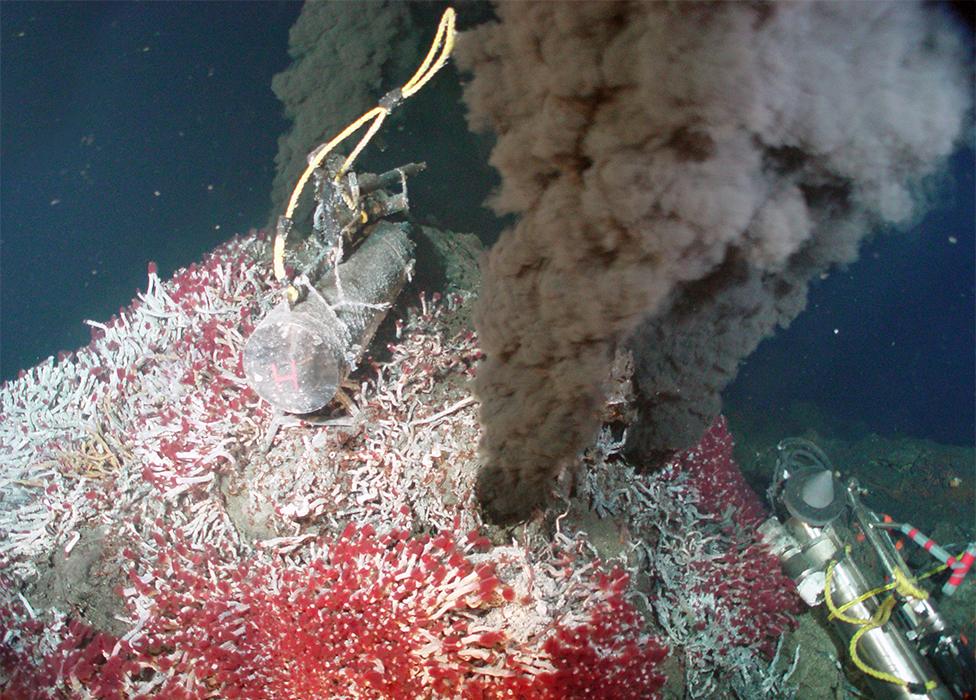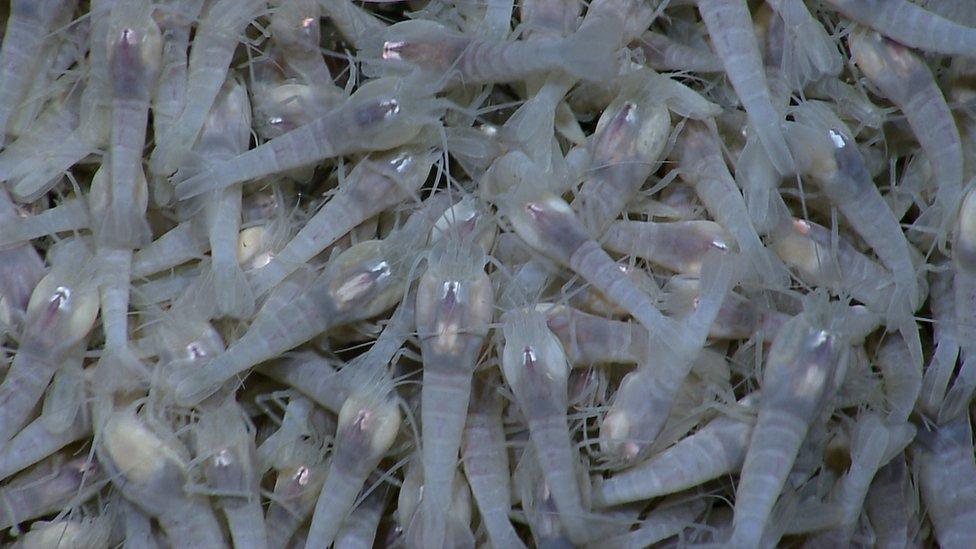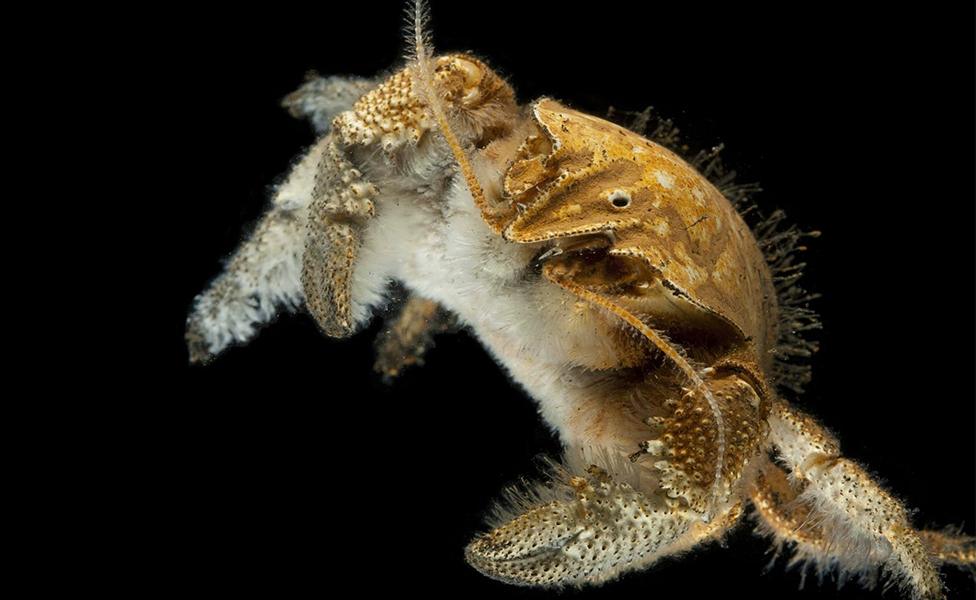Marvels of the deep and their superpowers
- Published

A vent system belching hot water and surrounded by tubeworms
Maggie Georgieva is turning a jar of preservative around in her hands. "This is it," she says. "This is 'The Hoff' - the famous yeti crab with a hairy chest," referring to the object suspended in alcohol.
Most of us would be hard pressed to name a recently discovered creature from the deep, and this animal may even be the only one that triggers any sort of recognition.
The Hoff made headlines in 2012 after being spotted living 2,000m down in a volcanic region of the Southern Ocean.
A novel species, the researchers who found it joked that the crustacean's fluffy appearance had something in common with a certain American movie star. The nickname stuck.
Maggie Georgieva: "Vent animals mass in large numbers"
Of course, The Hoff eventually got a proper title, external and description. It's correctly called Kiwa tyleri. And, as is customary, reference examples were lodged at the Natural History Museum in London, external, which is how a specimen comes to be in the hands of Dr Georgieva.
She's fascinated by hydrothermal vents. These are volcanic systems found along mid-ocean ridges - places where new sea-floor is created by the upwelling of magma.
In some locations, water can get drawn through cracks in the hot rock and become loaded with dissolved metals and other chemicals, before then being ejected back into the ocean. Specialised bacteria are able to exploit these hot fluids (up to 400C), to provide the energy foundation for a beautiful and bizarre collection of more complex organisms.
The Hoff, for example, "farms" the bacteria on its hairy chest. Comb-like mouthparts scrape up the microbes into a meal.

Hoff crabs filmed around volcanic vents on the Southern Ocean floor
Dr Georgieva has another jar in her collection of what are known as tubeworms.
These do symbiosis in a slightly different way. The animals have no mouth parts, no stomach and no gut. Instead, they possess an organ called a trophosome which acts as a kind of shelter for the bacteria. The microbes pay their rent to the worms in nutrients.
Yet another jar contains a little shrimp, Rimicaris. It nurtures the bacteria under its shelly hood, or carapace. Rimicaris will swarm around vents in vast numbers. Thousands per square metre.
The shrimp needs to keep its farm of microbes in the optimum waters - close enough to make use of the scalding fluids and their chemical bounty, but not so close that there's a risk of getting cooked.

Rimicaris will swarm in vast numbers
Rimicaris has no eyes, just an "eye-spot" - a concentrated patch of the light-sensitive pigment rhodopsin on its back. The thinking is it can use this feature to detect thermal radiation. But this cliff-edge existence is nothing compared with the peril faced by the fourth creature in Dr Georgieva's vent collection - the Pompeii worm.
It builds paper-thin tubes on the sides of the "chimney" structures where the fluids emerge. Temperatures inside these dens can top 80C. "Pompeii" seems an apt name and the worm uses a thick blanket of bacteria to help insulate it from harm.
"The remarkable thing about hydrothermal vents is that they can produce these unique and strange adaptations in animals," says Dr Georgieva. "We're trying to get an idea of how quickly animals can adapt to these environments. The adaptations tend to be related to getting symbionts and dealing with the harsh conditions, obviously.
"In order to get symbionts, one thing you have to do is make changes to your immune system - which you might expect because there'll be some bacteria you want to let in but others that you don't."

One interesting question is how some of the creatures have spread so far around the globe.
Vents are nutrient-rich oases in what is otherwise a resource-poor environment thousands of metres down from the sunlit surface of the ocean. And yet the likes of The Hoff and its five yeti-crab cousins have managed to reach widely separated volcanic ridges across the Southern Hemisphere, external.
Their last common ancestor probably lived 30-40 million years ago in the eastern Pacific. What we see today is the result of successful colonisations of vents by dispersed larvae. (Females release mini-Hoffs in big numbers to drift through the water column, some potentially making it to the next vent system).
It's all very precarious, to say the least, because vent systems are patchy. What is more, they will switch on and off through time, and when one dies so do all the local animals. Somehow a species must inhabit multiple locations - multiple stepping stones along a ridge - so that if one foothold is temporarily lost, the overall population will remain robust.

The Hoff is one of six yeti crab species
It's like a game of Whac-A-Mole, says yeti crab expert Nicolai Roterman from Oxford University. Successful dispersion ensures a species can pop back up in a new location. But the worry now is that certain human activities might soon load the game in favour of extinction by widening the gap between the places where a species could re-emerge.
It is one of the dangers posed by the proposed mining of metals at hydrothermal vents, believes Dr Roterman.
"The critical thing is if you start ploughing through and bulldozing hydrothermal vents, this human activity effectively simulates what is already happening naturally. It's then possible you could get to a situation where a meta-population simply collapses because it can't be sustained anymore."
The United Nations is meeting this week to begin discussions on the formulation of a treaty that would better regulate certain activities on the high seas - deep-sea mining among them.
Some of the creatures described by Nerc-funded, external Dr Georgieva - such as the Pompeii worm - can be seen currently in the Life In The Dark exhibition at the Natural History Museum, external.